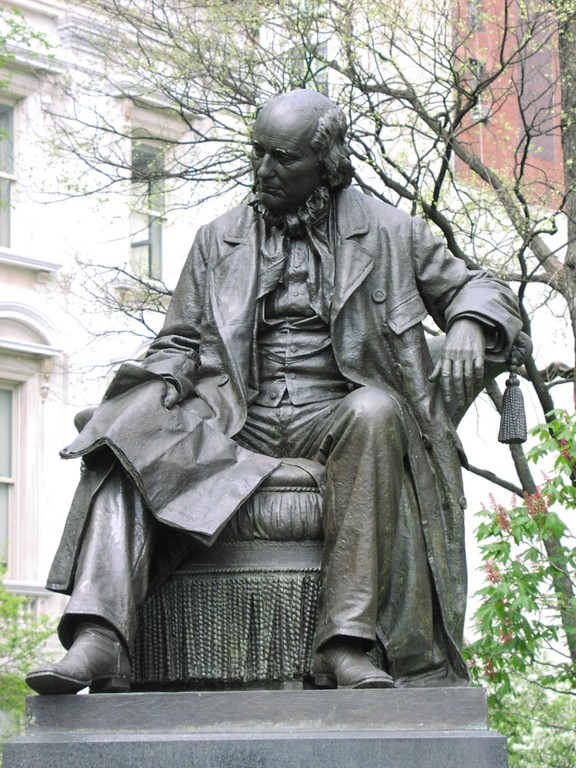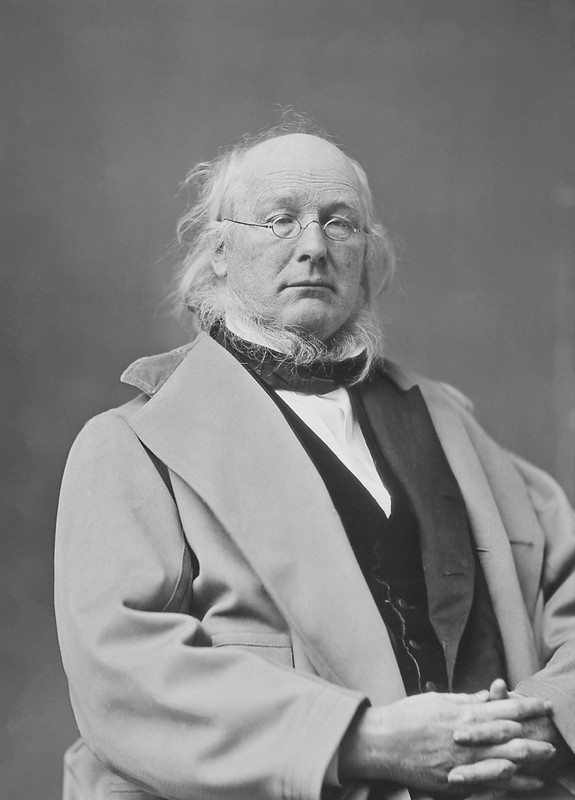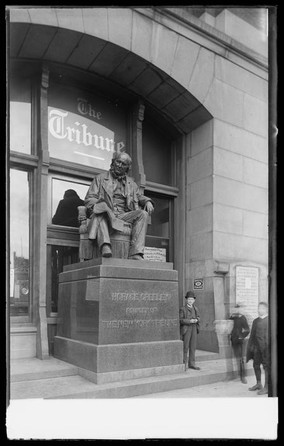Horace Greeley Statue
Introduction
Text-to-speech Audio
Images
Horace Greeley Statue in City Hall Park
.jpg)
A closer look at the statue

Horace Greeley (1811-1872)

The statue in its original location in front of the Tribune building (c. 1891)

Backstory and Context
Text-to-speech Audio
Horace Greeley was born to humble beginnings in the farming community of Amherst, New Hampshire on February 3, 1811. His father, Zaccheus, owned a small farm and occasionally worked as a day laborer. Due to his family’s economic struggles, Greeley attended school irregularly as a boy. Nevertheless, he became a voracious reader. In 1826, Greeley began an apprenticeship with the editor of a daily newspaper in East Poultney, Vermont. After the periodical ceased publication, he moved to Erie County, Pennsylvania, where he remained for a short time. In 1831, seeking greater opportunities, Greeley moved to New York City. There, he survived by working various jobs. Three years after arriving in the city, Greeley used what money he managed to save to establish a weekly literary and news publication, the New-Yorker.
While the periodical attempted to grow its readership and become profitable, Greeley became involved in politics to make ends meet. Throughout the late 1830s, he wrote regularly for a Whig newspaper and edited campaign sheets. It was also during this period that Greeley made the acquaintance of Thurlow Weed, an influential Albany newspaper editor and Whig political organizer. Weed not only paid him to serve as editor of a short-lived political newspaper that supported William Seward’s 1838 gubernatorial campaign (the Jeffersonian), but also helped him launch a political periodical of his own that supported William Henry Harrison’s 1840 White House bid, the Log Cabin.
In 1841, Greeley founded the New-York Tribune. The Whig periodical covered a wide variety of topics from news, politics, and social reform to book reviews, lectures, and poetry. In his editorial columns, Greeley spoke out against capital punishment, gambling, liquor, and prostitution, while championing education, Free Soil ideology, and westward expansion. The Tribune proved a tremendous success, becoming one of the nation’s leading newspapers by the Civil War. Consequently, Greeley became one of the most powerful newspaper editors in the nation.
In the 1850s, Greeley’s views on slavery influenced him to join a new national political party. Having broad political support in both the North and the South during the antebellum era, the Whig Party consequently took an ambivalent stance on the topic of slavery. Believing slavery to be an immoral institution that was also economically backward, Greeley gravitated toward the fledgling Republican Party. He attended the party’s organizational meeting in 1856 and its national convention in 1860, where he cast a ballot for Abraham Lincoln.
During the Civil War and Reconstruction, Greeley generally sided with the Radical Republicans. The editor of the Tribuneapplauded the Emancipation Proclamation, supported racial equality, and advocated for the impeachment of President Andrew Johnson. Greeley’s controversial decision not to support Lincoln’s reelection in 1864 hurt his popularity across the country. In 1867, hoping to quickly restore relations with the South after the war, he not only pushed for Jefferson Davis’ release from prison, but also signed the former Confederate president’s bail bond. Disturbed by the level of corruption in the Grant administration, Greeley ran against the incumbent president in 1872, but was sounded defeated. Only a few weeks after the election, he died in New York City at the age of sixty-one.
Following Greeley’s death, the Tribune launched a fundraising campaign to erect a statue in honor of its founder and long-time editor. The fundraising effort progressed slowly, in large part due to the Panic of 1873. The periodical eventually commissioned renowned sculptor John Quincy Adams Ward to design the statue and preeminent architect Richard Morris Hunt to design the pedestal. Ward’s work depicts Greeley sitting in an upholstered chair holding a newspaper. Dedicated on September 20, 1890, the over-life-sized bronze statue sits on a pedestal made of Quincy granite. Originally located in front of the Tribune building, the statue was moved in 1916 to the northeast corner of City Hall Park, where it remains today.
Sources
"Horace Greeley." Encyclopædia Britannica. Web. 19 January 2021 <https://www.britannica.com/biography/Horace-Greeley>.
"Horace Greeley." New York City Department of Parks and Recreation. The City of New York. Web. 19 January 2021 <https://www.nycgovparks.org/parks/city-hall-park/monuments/637>.
"Horace Greeley." Tulane University. Web. 19 January 2021 <https://www.tulane.edu/~sumter/Greeley.html>.
Vaughn, Steven L., ed. Encyclopedia of American Journalism. New York: Routledge, 2008.
https://commons.m.wikimedia.org/wiki/File:Monument_to_Horace_Greeley,_City_Hall_Park,_Manhattan,_New_York_(7237315508).jpg
https://diannedurantewriter.com/horace-greeley-city-hall-park
https://en.wikipedia.org/wiki/Horace_Greeley
http://dcmny.org/islandora/object/nyhs%3A302
